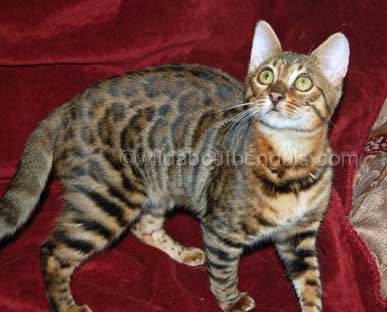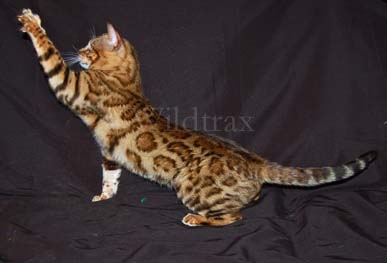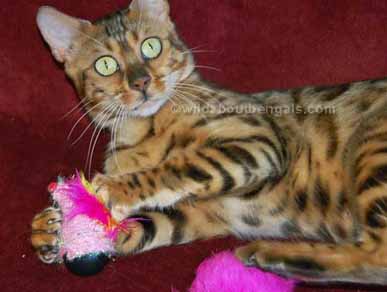 |
|
|
|
|
Bengal Breed
Profile
|
|

The Bengal cat breed began in 1963, and they are
descended from crossing the wild cat known as
the Asian Leopard Cat, (a small, forest-dwelling
cat found in Asia and India), and domestic shorthair
cats such as Abyssinians, American Shorthairs,
Burmese or Egyptian Maus. The goal of the Bengal
breed was to create a domestic cat which has the
physical features distinctive to it's wild ancestor,
but with the loving dependable temperament of
the domestic cat.
|
| Breed Background
 The
best companion Bengals are at least four generations
removed from the Asian Leopard Cat. Most pet Bengals
are wild only in looks, not in personality. An
SBT (stud book tradition) Bengal represents at
least five generations or more of Bengal-to-Bengal
breeding, and thus will be no less than five generations
removed from wild blood. The SBT Bengal is considered
to be a fully domestic cat. F1 through F4 (foundation)
Bengals are anywhere from one to four generations
away from the Asian Leopard Cat. (first, second,
third, and fourth generation removed from the
wild.) A F1 Bengal is the result of a Domestic
Cat-to-Asian Leopard Cat breeding creating a 50%
wildcat cross, an F2 is the result of breeding
a F1 Bengal to a SBT Bengal creating a 25% wildcat
cross, An F3 would be the result of breeding an
F2 and SBT together, and so on). An SBT cat would
thus be at least an F5. Most pet Bengals are SBTs;
cats with more wild blood than that may make difficult
pets. F1 through F4 Bengals may also be illegal
in some cities, counties, or states because of
their higher percentages of wildcat blood, while
SBT Bengals are not in most cases. The
best companion Bengals are at least four generations
removed from the Asian Leopard Cat. Most pet Bengals
are wild only in looks, not in personality. An
SBT (stud book tradition) Bengal represents at
least five generations or more of Bengal-to-Bengal
breeding, and thus will be no less than five generations
removed from wild blood. The SBT Bengal is considered
to be a fully domestic cat. F1 through F4 (foundation)
Bengals are anywhere from one to four generations
away from the Asian Leopard Cat. (first, second,
third, and fourth generation removed from the
wild.) A F1 Bengal is the result of a Domestic
Cat-to-Asian Leopard Cat breeding creating a 50%
wildcat cross, an F2 is the result of breeding
a F1 Bengal to a SBT Bengal creating a 25% wildcat
cross, An F3 would be the result of breeding an
F2 and SBT together, and so on). An SBT cat would
thus be at least an F5. Most pet Bengals are SBTs;
cats with more wild blood than that may make difficult
pets. F1 through F4 Bengals may also be illegal
in some cities, counties, or states because of
their higher percentages of wildcat blood, while
SBT Bengals are not in most cases.
|
| Physical Appearance
 The
Bengal cat is a medium to large, sleek and well
muscled cat, with hindquarters slightly higher
than shoulders. Female Bengals average from 7
to 10 pounds at maturity, and males can average
from 12 to 16 pounds at full growth. The body
is long and very muscular, resembling the Asian
Leopard Cat's powerful appearance. The head is
a broad modified wedge-shape and is longer than
it is wide. Large almond-shaped eyes, set wide
apart, and short rounded ears enhance the "wild"
look. The Bengal's glossy luxurious coat is short
with a thick unusually soft texture. Bengals do
not shed as much as other breeds, and their coats
require no special care. The coat is patterned
in random spots or marbled, with a variety of
acceptable colors. Like snowflakes, no two Bengals
have the same pattern. The
Bengal cat is a medium to large, sleek and well
muscled cat, with hindquarters slightly higher
than shoulders. Female Bengals average from 7
to 10 pounds at maturity, and males can average
from 12 to 16 pounds at full growth. The body
is long and very muscular, resembling the Asian
Leopard Cat's powerful appearance. The head is
a broad modified wedge-shape and is longer than
it is wide. Large almond-shaped eyes, set wide
apart, and short rounded ears enhance the "wild"
look. The Bengal's glossy luxurious coat is short
with a thick unusually soft texture. Bengals do
not shed as much as other breeds, and their coats
require no special care. The coat is patterned
in random spots or marbled, with a variety of
acceptable colors. Like snowflakes, no two Bengals
have the same pattern.

Bengals are most commonly seen in the "brown
spotted" (aka BST) or "leopard spotted"
pattern, which encompasses a wide range of colors.
The spots can be black, brown, tan, chocolate
or cinnamon and contrast with the background color.
Glittering refers to an effect on the coat that
makes it looks as if the coat was sprinkled with
glitter. Rosetted refers to the spots forming
distinct patterns, preferably with more than one
color tone within the spot. Vivid markings with
sharp contrast of colors is the mark of a show
Bengal. Seal sepia, seal lynx, and seal mink,
color patterns with a pale white or cream background,
are popularly referred to as "Snow"
Bengals. Bengals can also come in the Silver color, with black spots on a dove
grey background. Blues and Charcoals
are found in the breed, but these are not "accepted" colors for
the breed standard currently.
|
| Personality
 Bengals
are lively, energetic cats with a healthy dose
of feline curiosity. Graceful, strong, and agile,
Bengals love to climb and will gravitate to the
highest point in any room. Almost uncannily intelligent,
Bengals learn quickly and can be taught a number
of tricks, such as playing fetch. In fact, some
learn tricks you'd rather they didn't, such as
opening cupboards, turning on and off light switches
and flushing toilets. Well-bred Bengals are active,
playful, affectionate, family companions. Bengals
are very affectionate and like to give you "headbutts"
as a greeting, along with lots of leg rubs. Some
Bengals can be very talkative. Bengals love water,
and will splash in the sink or toilets, or even
jump into the shower with you. Bengal owners find
that they are very "dog-like" in personality,
following you from room to room and always greeting
you with a loving welcome. The Bengal also mixes
well with children and other animals. Bengals
are lively, energetic cats with a healthy dose
of feline curiosity. Graceful, strong, and agile,
Bengals love to climb and will gravitate to the
highest point in any room. Almost uncannily intelligent,
Bengals learn quickly and can be taught a number
of tricks, such as playing fetch. In fact, some
learn tricks you'd rather they didn't, such as
opening cupboards, turning on and off light switches
and flushing toilets. Well-bred Bengals are active,
playful, affectionate, family companions. Bengals
are very affectionate and like to give you "headbutts"
as a greeting, along with lots of leg rubs. Some
Bengals can be very talkative. Bengals love water,
and will splash in the sink or toilets, or even
jump into the shower with you. Bengal owners find
that they are very "dog-like" in personality,
following you from room to room and always greeting
you with a loving welcome. The Bengal also mixes
well with children and other animals.
|
| Health Care
 Bengals
are generally a healthy breed if you purchase
from a reputable and responsible breeder, and
they don't require any specialized care. Bengals
are subject to the same feline diseases as all
cats, and health care is no different than any
domestic breed of cat. They do seem to have sensitive
digestive systems, so they do not do well on varied
diets. Varied diets tend to give them the runs
or soft stools, but to avoid it, you just simply
keep them on a strict diet of the same brand of
food all the time and do not switch brands of
food randomly. (no table food scraps!) I find
they are much healthier all around if I keep them
on a raw meat diet with supplements. There are many good brands of commercial food
out there; preferably with a high meat content and less grains, veggies, and fruit in it the better. Higher price does not always equal higher quality food either, read the labels! You can do research on the different
foods on the internet and choose a good one, there's
no one real "magic" or best food out
there. Bengals
are generally a healthy breed if you purchase
from a reputable and responsible breeder, and
they don't require any specialized care. Bengals
are subject to the same feline diseases as all
cats, and health care is no different than any
domestic breed of cat. They do seem to have sensitive
digestive systems, so they do not do well on varied
diets. Varied diets tend to give them the runs
or soft stools, but to avoid it, you just simply
keep them on a strict diet of the same brand of
food all the time and do not switch brands of
food randomly. (no table food scraps!) I find
they are much healthier all around if I keep them
on a raw meat diet with supplements. There are many good brands of commercial food
out there; preferably with a high meat content and less grains, veggies, and fruit in it the better. Higher price does not always equal higher quality food either, read the labels! You can do research on the different
foods on the internet and choose a good one, there's
no one real "magic" or best food out
there.
|
| Coat Development
 Like
many baby wild animals, all Bengals go through
an ugly duckling stage called the "fuzzies",
where they lose the clarity of their markings
before later regaining them with their adult coat.
Shortly after 2 weeks of age, Bengal kittens develop
a long coat of "guard hairs", usually
black or dark gray, that can obscure
their dramatic spotted appearance somewhat. The guard hairs
can mute their markings, especially from the front
view, so their color and pattern can be difficult
to distinguish. You can usually look at their
coats from behind to see their coat pattern a
little better during this stage. Unfortunately,
the "fuzzies" are at their worst at
about ten weeks old, when kittens are first ready
to go their new homes. This is quite normal. They
typically shed their kitten coats somewhere around
16 to 25 weeks of age, but it varies from one
individual kitten to another. Like
many baby wild animals, all Bengals go through
an ugly duckling stage called the "fuzzies",
where they lose the clarity of their markings
before later regaining them with their adult coat.
Shortly after 2 weeks of age, Bengal kittens develop
a long coat of "guard hairs", usually
black or dark gray, that can obscure
their dramatic spotted appearance somewhat. The guard hairs
can mute their markings, especially from the front
view, so their color and pattern can be difficult
to distinguish. You can usually look at their
coats from behind to see their coat pattern a
little better during this stage. Unfortunately,
the "fuzzies" are at their worst at
about ten weeks old, when kittens are first ready
to go their new homes. This is quite normal. They
typically shed their kitten coats somewhere around
16 to 25 weeks of age, but it varies from one
individual kitten to another.
|
| Is A Bengal Right For You?
 Bengals
form strong, emotional bonds with their human
friends, and become loving, loyal companions.
Because of their deep attachment to their humans
and their high activity level, they need more
human interaction than some breeds. If you're
away all day and have an active social life at
night, another breed might be a better choice.
Young Bengals are quite hyperactive and excitable
and take a few months to learn their manners.
They have energy to spare, and seem to have two
modes; the "ON" mode, when they tear
round the house, leaping, and climbing, and the
"OFF" mode, when they flop into an exhausted
heap. Two Bengal kittens will exercise each other
far more effectively than you can, and will love
having a constant playmate should you not be in
the house all day. Bengals that don't have an
outlet for all their energy can get into trouble
or mischief around the house during your absence. Bengals
form strong, emotional bonds with their human
friends, and become loving, loyal companions.
Because of their deep attachment to their humans
and their high activity level, they need more
human interaction than some breeds. If you're
away all day and have an active social life at
night, another breed might be a better choice.
Young Bengals are quite hyperactive and excitable
and take a few months to learn their manners.
They have energy to spare, and seem to have two
modes; the "ON" mode, when they tear
round the house, leaping, and climbing, and the
"OFF" mode, when they flop into an exhausted
heap. Two Bengal kittens will exercise each other
far more effectively than you can, and will love
having a constant playmate should you not be in
the house all day. Bengals that don't have an
outlet for all their energy can get into trouble
or mischief around the house during your absence.
|
| More Bengal Breed Links:

http://bengalcat.com/
https://cfa.org/bengal/
http://www.tibcs.com/whatis.aspx
http://en.wikipedia.org/wiki/Bengal_cat
https://bengalrescue.org/
https://www.facebook.com/bengalrescuenetwork/
|
| You can also find more info about the Bengal breed
on our FAQ page and be sure
to check out our Breed
Comparison Chart if you need help deciding on
which of our breeds is the best fit for your family.
After you have researched more about the bengal
breed, if you are still unsure if a bengal is right
for you, please contact us and we will be happy
to help evaluate your home for compatibility with
a bengal. |
| |
|
|
|
|
 |